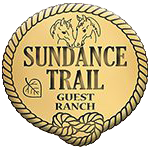Western Riding Dude Ranch Guide: Neck Reining
This is a collection of tips and sage advice from a number of dude ranch sources and folks here.
Sundance Trail Guest Ranch Wranglers shall teach their guests neck reining, only after the guests have demonstrated basic skill with direct reining. Teaching shall use the following principles:
First
- Hold both reins in one hand. Traditionally Western riders hold the reins in their non-dominant hand, leaving their dominant (most often right) hand free to do work like handle a rope or open a gate. Your hand will be centered a few inches in front of your body. Your hand will be ‘thumb up’ and the free end of your reins will be coming from the bottom of your hand.
- To turn left, lift your hand slightly and move it left to lay the right rein on the right side of the horse’s neck. No pressure should be applied to the bit.
- Gently “push” with your outside foot.
- As soon as the turn is complete release the pressure and bring your hand back to center.
- To turn right, lay the left rein against the horse’s or pony’s neck and cue with the right leg to help your horse bend.
Tips:
- Keep your shoulders square even though you are holding one hand higher to grasp the reins.
- Switch rein hands every so often on long rides may help even out the load on your horse’s back.
- As you practice, your rein aids will become more refined and almost imperceptible.
- Don’t lift your hand too high as this will encourage the horse to raise his head.
- Don’t pull back while turning. Your horse may think you’re cuing to stop, or become confused.
A Second Way to Say the Same Thing:
- To start neck reining, ride with both hands on the reins.
- Ride at a slow walk on a loose rein. To turn left, use light pressure on the left (inside/direct rein) while laying the right (indirect/outside or “neck” rein) against the horse’s neck just in front and above the withers.
- At the same time, bring your right leg on — use your right leg to aid the horse with light pressure. Gently “push” with your outside foot.
- Remember to look where you want to go and the horse will learn to follow this through your seat.
- Don’t pull back on the right (“neck”) rein, just lay it against the horse’s neck and bring your hand across the center of his neck. The horse will turn left.
- To turn right, reverse this process, using your left rein against his neck and your left leg to cue the turn.
A third set of ideas:
- If you want to go to the left, you pick your hand up toward your left knee and lay the right rein lightly against the horse’s neck. On a finished horse, the true neck rein is a loose rein – there’s only pressure against the neck and no pressure with the bit at all.”
- The neck rein cue should be very light, and the reining hand should never cross an imaginary line from the horse’s neck to the rider’s shoulder.
Avoiding Common Mistakes
- The most common mistake a rider makes is when he wants to turn but the horse won’t, so the rider pulls his hand farther to the inside. “But the farther your hand goes inside, the more pressure you’re putting on the outside rein, which forces the horse’s head to turn to the outside,” If the horse doesn’t turn, make the correction by going to two hands and shortening the inside rein (direct reining). “Put their nose slightly to the inside and move the horse’s shoulder over.”
- We often see riders using just one rein to get a turn. “A lot of people just pull the rein to the right when they want to turn right. Pretty soon the horse just turns his head to the right, but his shoulder is still off to the left, the hips are swung to the left, and they lose the whole body position.” “You’ve got to use both reins on the horse to keep his body lined up. You’d like for the head to be slightly to the right with his body still going straight. Use more left rein to move the horse’s left shoulder over and to keep his body alignment correct. This is important in all stages, but especially in the first few months.”
- Another problem is busy hands. “A lot of people, when they’re just riding along, move their hands all the time, even advanced riders in a show.” This constant hand movement sends conflicting signals and could eventually make the horse immune to neck reining cues.
- Some riders make neck reining for the green horse unnecessarily complicated. “Some people say if you want to turn to the left, you put your left foot here and your right foot there and your hand goes over here.” “Keep it very simple so the horse can understand: A neck rein means to turn. Use your legs to keep the motion or as punishment.” The only exception is a slight leg cue for the finished horse when performing a spin or a fast lope.
- By far the worst mistake a rider can make is inconsistency and not following through. Always insist on getting some sort of turn when you ask, and always reward by releasing. “If you continue to pull across their neck and nothing happens, they learn to ignore the pull. Every time the left rein touches the side of their neck, you must make them turn slightly to the right, then release the pressure.”
